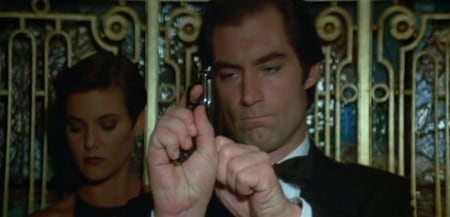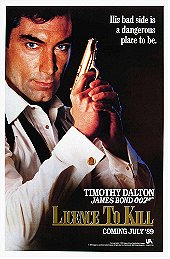Released in 1989, Licence to Kill denoted the end of the "classic Bond" era. Not only was this the last Bond-buster actively produced by the legendary Albert R. "Cubby" Broccoli, but it was also the last Bond film directed by series regular John Glen, and it features the franchise's last opening titles sequence to be designed by Maurice Binder. More notably, it was the final 007 adventure (of only two) for lead star Timothy Dalton, and, unfortunately, it was the first Bond film to disappoint at the American box office. Following Roger Moore's increasingly campy and goofy 007 outings, Licence to Kill revelled in the conventions of the '80s action movie movement, pushing for a gritty tone for the first time since the Connery era. Indeed, the film is closer to a brutal R-rated action film than a light-hearted Bond adventure, and it has received a lot of flack due to this. Yet, for this reviewer's money, the tonal change actually works here. Licence to Kill is a damn good Bond film; a well-constructed actioner with genuine stakes, solid acting and spectacular action.

In the Florida Keys, retiring CIA agent Felix Leiter (David Hedison) is getting married, and his buddy James Bond is the best man. The happy event is interrupted, however, when Bond and Leiter set off to capture notorious Columbian drug baron Franz Sanchez (Robert Davi), who unexpectedly shows up in the area. But after the wedding, Sanchez escapes and comes after Felix. When Bond finds Felix maimed and Felix's wife murdered, he refuses to pursue his next MI6 assignment, ignoring orders from M (Robert Brown) to concentrate on his own personal vendetta of vengeance against Sanchez. As a consequence, Bond is stripped of his job and licence to kill as he sets out to find Sanchez with help from ex-CIA operative Pam Bouvier (Carey Lowell) and beloved gadget expert Q (Desmond Llewellyn).
It's the audaciousness of Licence to Kill which makes it such a success in the eyes of this reviewer, as such risk-taking provides a unique edge. Michael G. Wilson and Richard Maibaum's screenplay shakes up the time-honoured Bond formula, shocking us with Felix's near-death and surprising us with Bond's decision to pursue a mission which has nothing to do with Her Majesty's Secret Service. Licence to Kill is exceedingly dark in tone, a notion which was unprecedented for the 007 series at the time. Aside from a handful of one-liners and a few colourful supporting turns (Wayne Newton is very funny as a televangelist), this is an edgy Bond flick mostly deprived of lunacy and humour. This is because the producers wanted to return to the spirit of Ian Fleming's novels with a more serious, leaner and meaner depiction of the iconic superspy. Alas, while viewers had started growing weary of the jokey Bond exploits, they still expected various Bond trademarks, like over-the-top villains, world domination schemes, inventive gadgets and a smattering of humour. Licence to Kill is mostly divorced of these staples, but filmgoers were not quite ready for such a change in 1989. With 2006's Casino Royale doing something similar with a much better reception, Licence to Kill was fundamentally ahead of its time.

Director John Glen was working with a $32 million budget - by no means tiny, but comparatively slight for this franchise. Thus, there were no huge Pinewood sets or lavish locations. Hell, nothing at all was shot in England; Licence to Kill was mostly shot in Mexico. Surprisingly, the restrictive budget actually works to the picture's benefit; its gritty, grounded disposition renders it far more exciting than a lot of masturbatory, big-budget blockbusters. There's just something inherently exhilarating about a back-to-basics approach. In keeping with the serious tone, Licence to Kill is the most graphically violent Bond film to date. So violent was the film that its more brutal death scenes had to be trimmed to earn a PG-13 rating in America, whereas all previous Bond films had earned an easy PG rating. (Luckily, the cuts were restored on recent home video editions.) The movie has a fair amount of quality action, all of which was competently staged by Glen. Most notable is the exhilarating climax involving tanker trucks that still impresses to this day. Michael Kamen's music is another huge asset. Kamen was a major '80s action luminary, having composed the music for Die Hard, Lethal Weapon, Road House and Action Jackson, among others. Gladys Knight's theme song also warrants a mention; it's enjoyable, but the '80s pop ballad sensibilities are not for everyone.
Dalton simply didn't get a fair shake as 007. He may not get much love and he's no Connery, but Dalton is a strong actor who had all the right qualities to play the character: he was a convincing man of action and had a degree of charm to him as well, not to mention he looked good in a tuxedo. Dalton's performance, which is much truer to Fleming's original creation than anything that audiences had seen in many years, gave Bond much-needed complexity and grit after the character had grown increasingly cartoonish. Not to mention, Dalton looks right at home within an '80s action film. Meanwhile, Davi is a nicely low-key Bond villain. Sanchez does not want to rule the world or cause grand destruction; he's just a vicious drug lord, and he's one hell of a rotten bastard. Of course, there are a few gorgeous women here as well - future Law & Order star Lowell is a top-notch Bond girl as Pam Bouvier, and Talisa Soto is extremely beautiful, too. A very young Benicio Del Toro also appears here playing one of Sanchez's henchmen. In terms of series veterans, Llewellyn remains lovable as Q, and Robert Brown (in his last Bond film) is a strong M.

Admittedly, Licence to Kill could have benefited from a faster pace, as the script does focus more on story and character development than balls-to-the-wall action. Such intricate writing may be appreciated, but the film bogs down from time to time (it does run a hefty 135 minutes). Added to this, some of the shark effects look laughably corny. Still, as Bond films go, Licence to Kill is definitely one of the strongest and most audacious in the franchise, not to mention it's highly entertaining. Interestingly, the original title was Licence Revoked, but the producers were not sure if Americans would understand the meaning of "revoked." So the title was changed to Licence to Kill, even though they used the British spelling of the word "licence." Another score for British Intelligence.
7.7/10
 Login
Login